Propeller basics
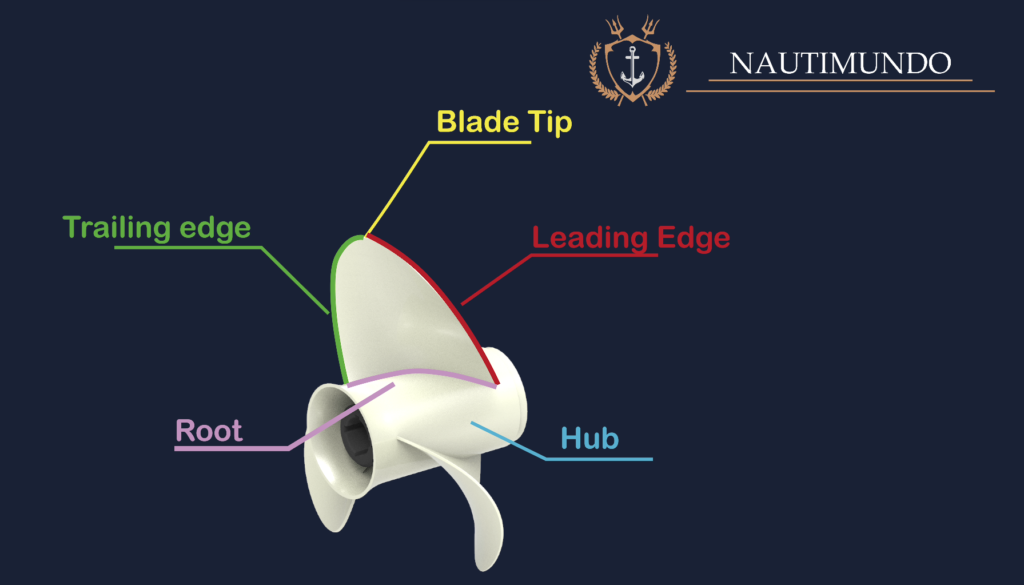
In this article, I have synthesized and explained as simply and clearly as possible the basic aspects of a propeller that any skipper or boat owner should know about propellers.
What is a propeller?
The propeller is a propulsive element that transforms the engine's mechanical energy into thrust. Propellers are made of equal blades equispaced around a hub.
How does a propeller work?
When the propeller rotates, a pressure difference is created between the two faces of the blades generating thrust. The blade has a pressure side and a suction side; on the pressure side, there is an overpressure which produces a thrust force, while on the suction side, there is a depression which generates a pulling force. The pressure face is facing aft, and the suction face is facing forward.
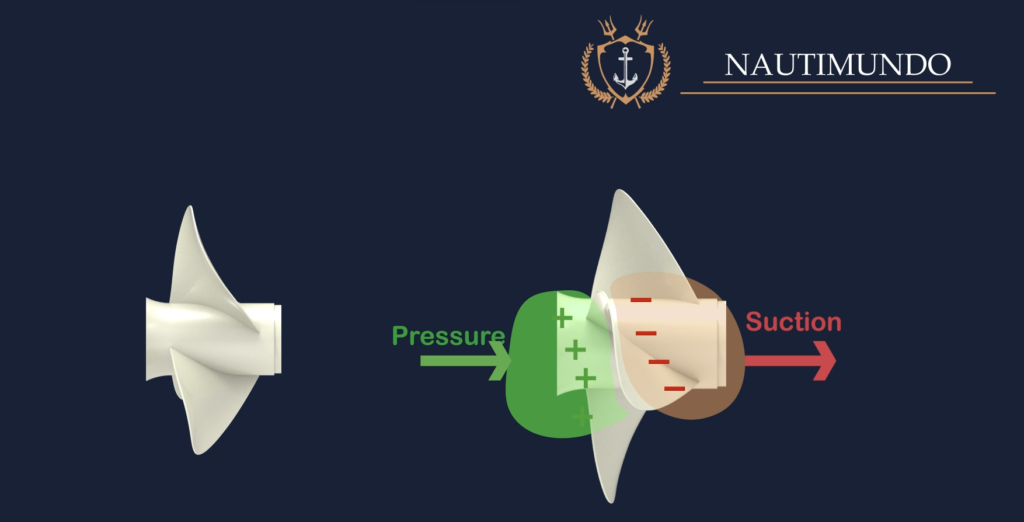
Nomenclature and basic parts of a propeller
Blade Tip
It is the furthest point on the blade from the center of the propeller hub, and it is the point that separates the leading edge and the trailing edge.
Trailing edge
It is the blade edge most aft of the propeller, where the water comes out of the blade.
Boss or Hub
It is the central part of the propeller where different blades are attached. The core of the propeller is attached to the shaft that will transmit the rotary motion.
Root
It is the lower edge of the blade, where the blade meets the propeller hub.

Blade Face
The blade face is the side of the blade that faces aft of the propeller and is the high-pressure face.
Blade Back
This is the side of the blade facing forward of the propeller. Blade Back is the propeller low-pressure side.
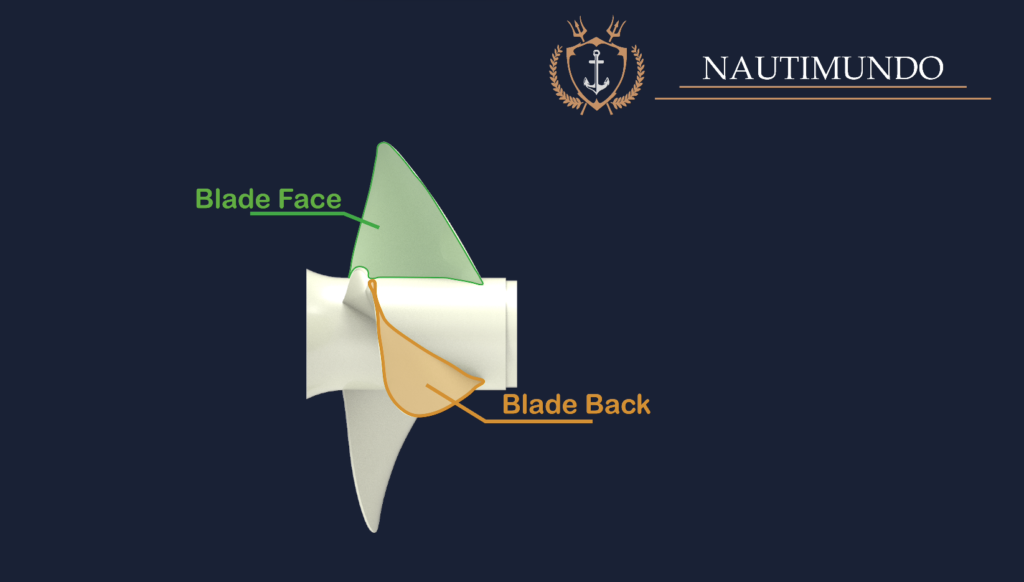
Cup
A small curve or lip on the trailing edge of the blade that some propellers have, which allows the propeller to hold water better reducing ventilation, slippage and the appearance of cavitation.
The cupped propellers are efficient at high speeds, above 35 knots, and operating at high RPM. In addition, they allow a slight increase in speed, between 5 and 10%.
This type of propeller has a higher true or virtual pitch. A general guideline when replacing a normal propeller with a cupped propeller is to choose a propeller with blades with 1 inch or 5% less pitch than the standard propeller installed.
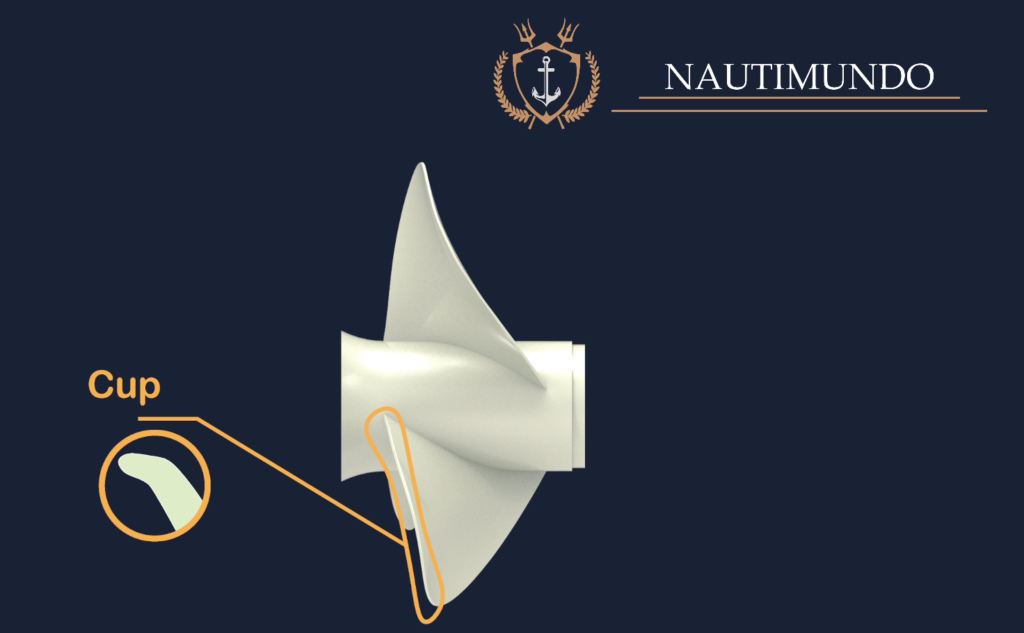
Propeller's diameter
The propeller's diameter is the diameter of the imaginary circle drawn through the tips of the blades. It can be easily calculated by measuring the distance between the center of the propeller and the tip of one of the propeller blades, obtaining the propeller radius, and multiplying this measure by two.
The larger the propeller's diameter, the more water it moves, generating more thrust, but this increased thrust requires more torque.
Blade area
The blade area, is the surface area of the individual propeller blades. The blade area directly affects a propeller’s tendency to cavitate and the power it absorbs.
The projected blade area and the developed or expanded blade area are usually measured. The projected blade area is the surface area of the blade as seen from the stern; this area is smaller than the area of the actual blade, as the blade is usually twisted.
The developed area is obtained by expanding or developing the curvature of the twisted propeller blade in a drawing, measuring the area obtained in the drawing. The developed area is usually the most used to realize the different calculations.
Propeller pitch (theoretical pitch)
The propeller's pitch is the theoretical distance the propeller will advance in one revolution, that is, one complete turnaround itself. This measurement is usually expressed in inches. Propellers with a higher pitch cause the boat to advance more per revolution.
Keep in mind that the propeller's pitch will be reduced in water by about 15% due to the water's drag and the propeller's slippage.
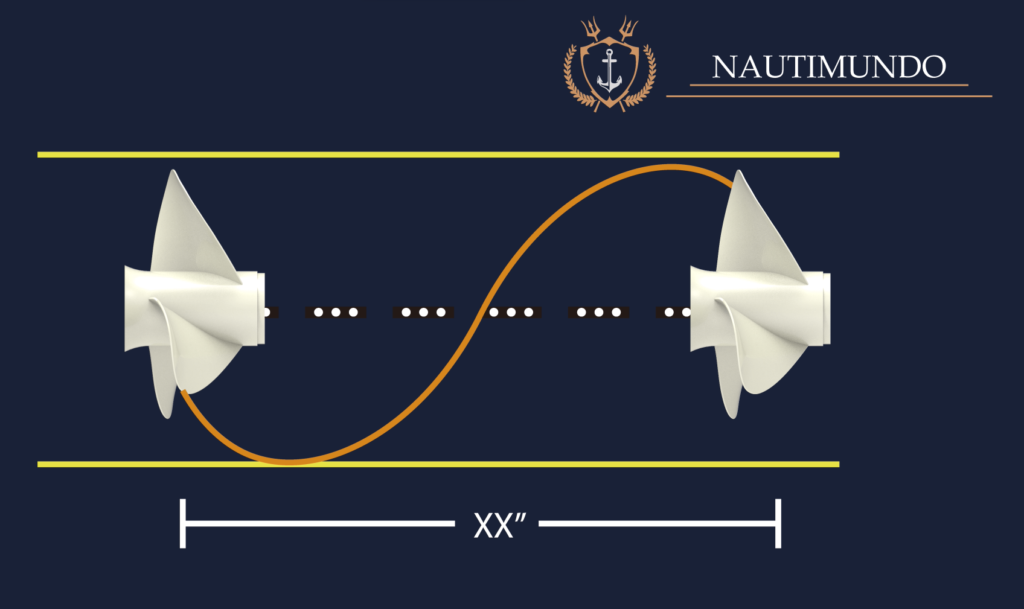
Propeller rotation direction or hand
Looking the propeller forward from the stern, the propellers can be left-hand or right-handed. The right-handed propellers, when they rotate clockwise, produce a thrust towards the bow, allowing the boat to move forward, while when they rotate counterclockwise, they produce a thrust towards the stern, allowing it to go backward. On the contrary, a left-handed propeller, when it rotates counterclockwise, produces a thrust forward, allowing the boat to move forward. In contrast, when it rotates clockwise, it produces a thrust aft, allowing it to go backward.
You can quickly tell a right-handed from a left-handed propeller by looking at it. Looking at the propeller from astern, if the blade's leading edge is to your right, the propeller will be right-handed, having to turn clockwise to get the boat forward. If the blade's leading edge is to your left, the propeller will be left-handed, having to turn counterclockwise to get the boat forward.
You cannot convert a left-handed propeller into a right-handed one and vice versa by changing its position on the shaft by turning it 180º. If a propeller with the wrong direction of rotation is obtained for your installation, it should be replaced with one with the correct direction of rotation.
In single-propeller vessels, right-handed propellers are most commonly used. In boats with twin propellers, the normal thing is that the two propellers are counter-rotating and that one rotates clockwise and the other counterclockwise.
In terms of maneuvering, for a single propeller vessel, the maneuvering is influenced by the "paddlewheel effect". When the vessel is stationary, and the propeller is started or sailing at low speed and accelerating rapidly, the propeller will move the stern of the vessel in its direction of rotation.
On twin-propeller boats, for greater propulsive efficiency and good maneuverability, the propellers should turn to the sides of the boat. The starboard propeller must be right-handed, and the port propeller must be left-handed. In this two-propeller configuration, the "paddlewheel effect" is compensated when both propellers rotate at the same number of RPM.
Number of Blades
Single-bladed propellers are the most efficient, but they have a big problem, the imbalance generated by having only one blade that causes a lot of vibrations. Therefore, a two-bladed propeller is the most efficient for achieving an adequate balance with far less vibration. The more blades a propeller has, the worse its performance is, but at the same time, the fewer vibrations and noise it generates.
Most propellers have three blades, providing a better balance between vibration, size, efficiency, and cost. The difference in efficiency between a two-bladed propeller and a three-bladed propeller is considered less significant than the difference in vibration levels. On the other hand, two-bladed propellers will generally require a larger diameter to achieve a large enough blade area to generate the necessary thrust.
Skew
If the propeller blade is projected in a plane perpendicular to the propeller axis and the points located in the middle of the projected sections are joined, a line is obtained. If this line is not perpendicular to the propeller axis, it is said that the propeller has skew or skew back, and therefore the blade contour is not symmetrical.
This skew means that the blade sections do not enter at the same time in the different zones allowing to compensate the radial differences in the water flow, produced by the hull and other elements installed in the hull that causes disturbances in the wake, giving the propeller a better hydrodynamic behavior, reducing vibrations and noise.
On the other hand, the increased expanded area makes skew propellers less prone to cavitation.
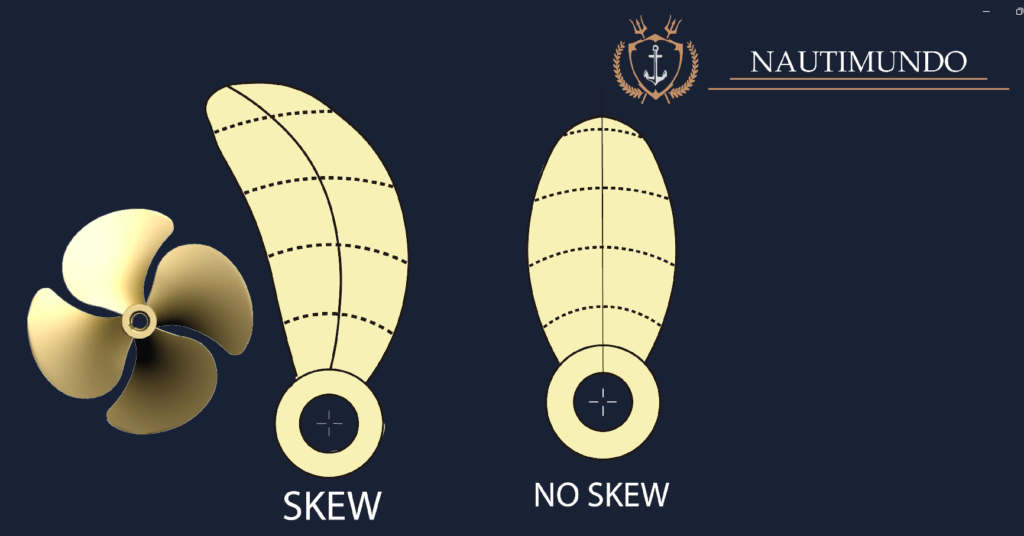
Rake
Rake, simply defined, is the angle between the blade and the propeller hub. But to be more precise, Rake is the inclination angle between the blade's generator line and the perpendicular to the propeller axis.
Forward-inclined blades have a negative rake angle, while backward-inclined blades have a positive rake angle. Rake is expressed in degrees or as the rake ratio.
For almost all standard applications, vertical blades are the optimal choice. Blades that rake aft are typically employed to gain a little extra effective diameter in confined spaces. This is because rake blades are longer and have a greater surface area than vertical blades with the same diameter. In addition, the raked blades, whose tips are located further aft, may take advantage of the hull's small upward sweep, allowing for a somewhat larger propeller diameter. Negative rake blades are often encountered on high-speed boats and heavily laden propellers.
Blade profile
If a blade is cut or sliced at right angles to the radius, an airfoil-shaped section can be observed. The geometry of this profile has a great effect on the thrust generated, the performance, and the overall operation of the propeller.
Slip
It is the forward distance lost in one propeller revolution, or in other words, the difference between the distance a ship advances through the water in one propeller revolution and the theoretical distance it would travel if it advanced the entire propeller pitch.
Slip should not be confused with propeller efficiency; they are different things. Slip is necessary to generate thrust; this phenomenon derives from the angle of attack of the propeller blades, which is essential to achieve thrust.
Cavitation
Cavitation is caused by extreme underpressure at the back of the propeller blade, which causes the water to boil or vaporize, and subsequently, those vapor bubbles collapse and return to a liquid state, releasing heat and energy. During normal operation, many propellers partially cavitate, but excessive cavitation can cause cavitation burns, erosion, or pitting on the blade surface.
Ventilation
This problem occurs when surface air or engine exhaust gases are drawn into the propeller blades. In most cases, ventilation results from having the propeller too close to the surface, as in the case of too-close turns, an engine mounted too high on the transom, or an engine with excessive trim. Ventilation can also be caused by poor propeller selection, which does not suit the boat.
That was all. We hope you liked the video. If you have any questions or would like us to make a video explaining in more detail any parts of this video or something related to the maritime world, you can leave us a comment.


Leave a Reply